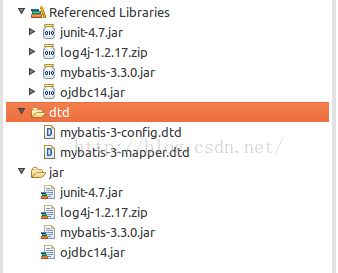Mybatis增删改查实例
Mybatis增删改查实例
编写一个简单的mybatis进行插入数据的实例
1 数据库建表 其中建表dob=Date of Birth 的意思 create table students
(stud_id number primary key,
name varchar2(20),
email varchar2(20),
dob date
);Oracle数据库中出现表已创建,则表示创建成功,如果出现名称已被使用,则可在建表之前进行删除操作:drop table students;或者进行级联删除drop table students cascade constraints;然后再重新创建
2 新建一个项目
2.1 创建好相应的package及class,其中Student是我们要进行插入的对象,由于数据类型和数据库中的值进行了对应,因此我们能够进行将一整个对象进行插入,因此我们使用pojo类进行封装对象
package com.mybatis.pojo;
import java.util.Date;
public class Student {
private Integer studId;
private String name;
private String email;
private Date dob;
public Student() {}//注意无参的构造器
public Student(Integer studId, String name, String email, Date dob) {
this.studId = studId;
this.name = name;
this.email = email;
this.dob = dob;
}
public Integer getStudId() {
return studId;
}
public void setStudId(Integer studId) {
this.studId = studId;
}
public String getName() {
return name;
}
public void setName(String name) {
this.name = name;
}
public String getEmail() {
return email;
}
public void setEmail(String email) {
this.email = email;
}
public Date getDob() {
return dob;
}
public void setDob(Date dob) {
this.dob = dob;
}
@Override
public String toString() {
return "Student [studId=" + studId + ", name=" + name + ", email="
+ email + ", dob=" + dob + "]";
}
}3 项目中引入mybatis的核心包以及可选的依赖包
文件下载:mybatis包下载
最新版下载:https://github.com/mybatis/mybatis-3/releases
必须的包 mybatis-3.3.0.jar ojdbc14.jar
可选的包 junit-4.7.jar log4j-1.2.17.jar
其中mybatis-3.3.0.jar 用于实现mybatis提供的功能,ojdbc14.jar用于连接数据库,junit-4.7.jar用于实现功能测试,log4j-1.2.17.jar用于进行日志记录
如下图所示:在项目目录下建立一个新的文件夹jar,将需要导入的包进行复制粘贴到jar目录下边
注意:在本地存放这些jar包时不要使用中文
然后再右键选中jar目录下的四个文件,点击添加“buildPath->add Path”,就能够看到如下界面:表示添加路径成功
4 项目中引入mybatis配置文件dtd约束文件
同样的,在项目下新建dtd目录,将约束文件复制到目录下即可,如下图所示:dtd文件结构,dtd文件下载:http://download.csdn.net/download/suwu150/9660699
dtd文件的作用是对配置文件xml进行约束,这样的话程序员就能按照规范书写xml文件,mybatis就能够正确的读取并解析,以上dtd是配置本地的,当然我们也能够使用官网的连接进行约束
5 mybatis中的配置文件和映射文件分别引入到项目中
1) src下面的mybatis-config.xml:
首先我们对本地dtd约束进行关联,如下图进入到Preferences下面,在搜索框中输入xml,选中xml catalog配置名,然后点击右边的add按钮
出现如下图所示界面,其中Location位置和key位置为空,下图是配置过的,key内容为-//mybatis.org//DTD Config 3.0//EN,Location内容为自己的,可以通过Workspace进行选择,也就是我们前面复制到项目中的dtd文件(第4步操作中的):
点击OK,现在我们能够进行xml配置文件的书写,添加约束的作用就是对程序员的书写进行规范,以保证mybatis能够正常解析
如下图所示:选中src右键创建新文件mybatis-config.xml注意:xml文件开头必须置顶,前面不能有空格
首先,我们实现接口com.mybatis.mappers;包下面新建一个接口StudentMapper.java,用来对应xml文件中的sql语句(映射),从而方便我们调用
package com.mybatis.mappers;
import java.util.List;
import com.mybatis.pojo.Student;
public interface StudentMapper {
List findAllStudents();
Student findStudentById(Integer id);
void insertStudent(Student student);
} 然后进行xml代码的编写:
INSERT INTO
STUDENTS(STUD_ID,NAME,EMAIL,DOB)
VALUES(#{studId},#{name},#{email},#{dob})
*******************************************************
注意:xml文件中写的sql语句,最后面不要写分号,否则会报错误,ORA-00911: 无效字符
*******************************************************
6 配置log4j.properties文件中的日志输出:
位置src下面,文件名log4j.properties内容:
log4j.rootLogger=DEBUG, stdout
log4j.appender.stdout=org.apache.log4j.ConsoleAppender
log4j.appender.stdout.layout=org.apache.log4j.PatternLayout
log4j.appender.stdout.layout.ConversionPattern=%d [%-5p] %c - %m%n
#show sql
log4j.logger.java.sql.ResultSet=INFO
log4j.logger.org.apache=INFO
log4j.logger.java.sql.Connection=DEBUG
log4j.logger.java.sql.Statement=DEBUG
log4j.logger.java.sql.PreparedStatement=DEBUG
7 创建一个测试类StudentMapperTest.java
package com.mybatis.test;
import java.io.IOException;
import java.io.InputStream;
import java.util.Date;
import org.apache.ibatis.io.Resources;
import org.apache.ibatis.session.SqlSession;
import org.apache.ibatis.session.SqlSessionFactory;
import org.apache.ibatis.session.SqlSessionFactoryBuilder;
import org.junit.Test;
import com.mybatis.mappers.StudentMapper;
import com.mybatis.pojo.Student;
public class StudentMapperTest {
@Test
public void test_insertStudent()
{
SqlSession session=null;
try {
// 获取配置文件
InputStream inputStream = Resources.getResourceAsStream("mybatis-config.xml");
// 生成工厂对象
SqlSessionFactory sqlSessionFactory = new SqlSessionFactoryBuilder().build(inputStream);
// 使用工厂对象生成sqlsession
session = sqlSessionFactory.openSession();
// 使用sqlsession获得映射接口的实现类对象,接口的引用指向实现类的对象
StudentMapper studentMapper = session.getMapper(StudentMapper.class);
Student student = new Student(1, "suwu150", "[email protected]",new Date());
studentMapper.insertStudent(student);
} catch (IOException e) {
session.rollback();
e.printStackTrace();
}
}
}
8 运行成功后会在控制台中看到log4j日志输出的这个程序运行的相关信息,如下:
在数据库中查询能够看到如下信息
9 对mybatis的一些基本封装
每次读取配置文件,产生一个工厂对象SqlSessionFactory,然后再生成出SqlSession对象,这个过程虽然并不复杂,但是也都是一些重复的代码流程,所以我们可以对其进行一个简单的封装:
package com.mybatis.utils;
import java.io.IOException;
import java.io.InputStream;
import org.apache.ibatis.io.Resources;
import org.apache.ibatis.session.SqlSession;
import org.apache.ibatis.session.SqlSessionFactory;
import org.apache.ibatis.session.SqlSessionFactoryBuilder;
public class MyBatisSqlSessionFactory {
private static SqlSessionFactory sqlSessionFactory;
public static SqlSessionFactory getSqlSessionFactory(){
if(sqlSessionFactory == null){
InputStream inputStream = null;
try {
inputStream = Resources.getResourceAsStream("mybatis-config.xml");
sqlSessionFactory = new SqlSessionFactoryBuilder().build(inputStream);
} catch (IOException e) {
e.printStackTrace();
throw new RuntimeException(e.getCause());
}
}
return sqlSessionFactory;
}
public static SqlSession openSession() {
return openSession(false); //默认手动提交,故我们在调用的时候需要进行提交
}
public static SqlSession openSession(boolean autoCommit) {
return getSqlSessionFactory().openSession(autoCommit);
}
}
上面的代码可简写为: //注意事务是自动提交还是手动提交
MyBatisSqlSessionFactory.openSession().getMapper(StudentMapper.class).insertStudent(s);
10 在上面的测试中,我们仅仅完成了增加的功能,下面我们进行实现删除修改和查询的功能:
在映射文件中进行如下配置:
INSERT INTO
STUDENTS(STUD_ID,NAME,EMAIL,DOB)
VALUES(#{studId},#{name},#{email},#{dob})
delete from students
where STUD_ID=#{id}
update students
set name=#{name},email=#{email}
where stud_id=#{studId}
package com.mybatis.mappers;
import java.util.List;
import com.mybatis.pojo.Student;
public interface StudentMapper {
List findAllStudents();
Student findStudentById(Integer id);
void insertStudent(Student student);
void deleteStudentById(Integer id);
void updateStudentById(Student student);
}
package com.mybatis.test;
import java.io.IOException;
import java.io.InputStream;
import java.util.Date;
import java.util.List;
import org.apache.ibatis.io.Resources;
import org.apache.ibatis.session.SqlSession;
import org.apache.ibatis.session.SqlSessionFactory;
import org.apache.ibatis.session.SqlSessionFactoryBuilder;
import org.junit.Test;
import com.mybatis.mappers.StudentMapper;
import com.mybatis.pojo.Student;
import com.mybatis.utils.MyBatisSqlSessionFactory;
public class StudentMapperTest {
@Test
public void test_insertStudent()
{
SqlSession session=null;
try {
// 获取配置文件
InputStream inputStream = Resources.getResourceAsStream("mybatis-config.xml");
// 生成工厂对象
SqlSessionFactory sqlSessionFactory = new SqlSessionFactoryBuilder().build(inputStream);
// 使用工厂对象生成sqlsession
session = sqlSessionFactory.openSession();
// 使用sqlsession获得映射接口的实现类对象,接口的引用指向实现类的对象
StudentMapper studentMapper = session.getMapper(StudentMapper.class);
Student student = new Student(2, "suwu150", "[email protected]",new Date());
studentMapper.insertStudent(student);
session.commit();
System.out.println("执行完毕");
} catch (IOException e) {
session.rollback();
e.printStackTrace();
}
}
@Test
public void test_deleteStudentById()
{
SqlSession session=null;
session = MyBatisSqlSessionFactory.openSession();//使用封装之后的类
// 使用sqlsession获得映射接口的实现类对象,接口的引用指向实现类的对象
StudentMapper studentMapper = session.getMapper(StudentMapper.class);
studentMapper.deleteStudentById(2);
session.commit();
System.out.println("执行完毕");
}
@Test
public void test_updateStudentById()
{
SqlSession session=null;
session = MyBatisSqlSessionFactory.openSession();//使用封装之后的类
// 使用sqlsession获得映射接口的实现类对象,接口的引用指向实现类的对象
StudentMapper studentMapper = session.getMapper(StudentMapper.class);
Student student = new Student();
student.setStudId(1);
student.setName("sususu");
student.setEmail("[email protected]");
studentMapper.updateStudentById(student);
session.commit();
System.out.println("执行完毕");
}
@Test
public void test_findStudentById()
{
SqlSession session=null;
session = MyBatisSqlSessionFactory.openSession();//使用封装之后的类
// 使用sqlsession获得映射接口的实现类对象,接口的引用指向实现类的对象
StudentMapper studentMapper = session.getMapper(StudentMapper.class);
Student student = studentMapper.findStudentById(1);
System.out.println(student);
System.out.println("执行完毕");
}
@Test
public void test_findAllStudents()
{
SqlSession session=null;
session = MyBatisSqlSessionFactory.openSession();//使用封装之后的类
// 使用sqlsession获得映射接口的实现类对象,接口的引用指向实现类的对象
StudentMapper studentMapper = session.getMapper(StudentMapper.class);
List list = studentMapper.findAllStudents();
System.out.println(list);
System.out.println("执行完毕");
}
}
这样我们就完成了对Student对象的增删改查








